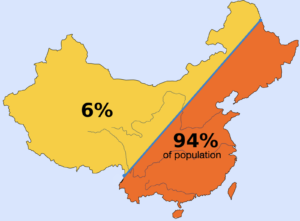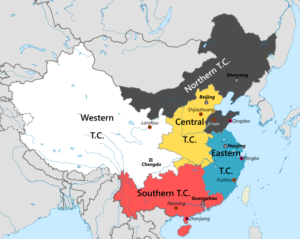China has given priority to translate science and technology achievements into military capabilities.
China’s military capability enhancements in the new era are characterized by an emphasis on new security domains.
On the one hand China has improved its long-distance force projection and precision strike capabilities in the respective domains of the Army, Navy, Air Force, and Rocket Force.
On the other hand, it has attached importance to new security domains, such as space, cyber, electromagnetic, and Information, as key fields for influencing the fate of future warfare.
China aims to overtake developed country’s militaries by making concentrated investments in state-of-the-art technologies and deepening military-civil fusion.
It hopes to achieve superiority in these fields and thereby overturn its inferiority in overall military capabilities.
China has already achieved the status of a major military power by 2021 (100th anniversary of its founding Chinese Communist Party).
The Xi Jinping administration has set ambitious goals to further establish China as a global power by the next centenary in 2049 (marking the 100th anniversary of the founding of the People’s Republic of China).
It aims to be leader in overall military capabilities by becoming a cyber-power, a space power, and a manufacturing power of defence hardware and software.
While “active defence” as a military strategic concept has been consistently advocated by the PLA, its content has evolved reflecting changes in China’s national power, the international environment, and industry structure, as well as advances in military technology.
Its active defence strategy has changed from the tenet of “striking only after the enemy has struck,” (i.e. luring the enemy into one’s territory and then making a counterattack), to offensive actions of active defence.
Active defence is expected to take on a more offensive nature in the military strategy in the new era.
China has prepared itself for future “unrestricted warfare”, across a variety of domains.
To achieve vital information dominance, especially in cyberspace, China has promoted her informatisation and reviewed her cyber strategy.
In the space domain, China gives weight to securing space dominance by maintaining its use of space, denying use of space by adversaries, and providing information support from space.
China has steadily increased the number of satellites that can be used for military purposes, its space access capabilities, and its space situational awareness capabilities. It also develops capabilities for interfering with an opponent’s use of space through anti-satellite (ASAT) weapons, electronic jammers, and other means.
The Government of China, which prioritizes the role of S&T in the military, has established the “military-civil fusion strategy” as a national strategy.
Under this strategy, the government makes concentrated investments in S&T in new security domains, facilitates military use of advanced technologies, and promotes indigenization of core technologies.
The Xi Jinping administration established the Central Commission for Military-Civil Fusion Development, a CCP organ that has been given powerful authority. Under the commission, the administration aims to build a management system through which organizations of the state, military, and society cooperate with each other for executing military-civil fusion policies.
Military-civil fusion efforts place particular emphasis on the cyber, space, and maritime domains.
The PLA’s informatisation of the military system and increased reliance on space assets in military operations have created vulnerabilities that accrue from attacks on these systems.
China has made a rapid rise in S&T, but it is still in the developing stage. Especially with regard to talent and specific core technologies.
The enhancement of China’s military capabilities in new security domains has fuelled international competition over core technologies and technological infrastructure.
The PLA has expanded its operational domains in parallel with the rise of its military capability, and is reinforcing the offensive element of active defense.
Implications for India
As it prepares for intelligentised warfare in this context, the PLA is likely to test operate new technologies and capabilities.
In the near future, besides other countries, India will also face confronting situations and be compelled to respond to them.
In the long run, fulfilling the “Chinese Dream” of “the great rejuvenation of the Chinese nation” would include resolving the disputes with neighbouring countries in a manner consistent with China’s wishes.
Enhancement of the PLA’s military capabilities, and belligerent attitude of China, would necessitate enhancement of India’s military capabilities on priority.
Looking ahead to the medium and long term trends of military technology, India needs to invest in technology infusion into its military.
India needs to re-orientate and reorganise to develop capability of warfare in strategic domains of space, cyber, electromagnetic, and information.
Thought
Time has come to spend on Military capability enhancement even if it is at the cost of development.
Do You Agree?
For regular updates please register here –
https://55nda.com/blogs/anil-khosla/subscribe/
References
NIDS China Security Report 2021.
https://thediplomat.com/2021/04/chinas-military-has-a-hidden-weakness/
https://www.lowyinstitute.org/the-interpreter/is-china-speeding-up-military-modernisation-it-may-but-its-not-yet
https://en.wikipedia.org/wiki/Modernization_of_the_People%27s_Liberation_Army
https://www.cfr.org/backgrounder/chinas-modernizing-military



